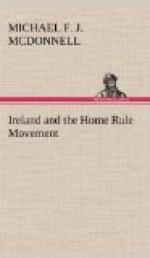If urban industrial conditions militate against an increase of lunacy, on the other hand it must be remembered that in most Irish towns there is an appalling amount of overcrowding. The death-rate of Dublin—the highest of any city in Europe—is, in consequence, no less than 25 per 1,000, as against 16 per 1,000 in Paris and New York, and 17 per 1,000 in London. The percentage of families, consisting on an average of four persons, living in one room is in London 14.6, in Edinburgh 16.9, in Glasgow 26.1, in Cork 10.6, in Limerick, 15.8, while in Dublin it reaches the appalling percentage of 36. In Belfast, which, unlike any other of the cities which I have mentioned, is for the most part modern, the percentage is not higher than 1, and this fact has a very great bearing on the industrial conditions in that city. Side by side with these figures may be placed those of the death-rate from tuberculosis, which from 1864 to 1906 in England decreased from 3.3 per 1,000 to 1.6, in Scotland decreased from 3.6 per 1,000 to 2.1, and in Ireland increased from 2.4 to 2.7 per 1,000.
The rate war of the steamship companies, which reduced the cost of passage across the Atlantic in 1904, caused the emigration returns to rise from 45,000 to 58,000 in a single year, and at the same time there were employed in Ireland two hundred emigration agents of one company alone—the Cunard—each of whom received six shillings a head for each banished Irishman and Irishwoman whom he got safely out of the country. It is easy for the Irishman to wax eloquent about the exiles who, from the time when O’Neil and O’Donnell weighed anchor in Lough Swilly at the very beginning of the seventeenth century, sailed from their country to seek their fortunes abroad in Church or State or camp, since proscription deprived them of the carriere ouverte aux talents at home. The history of the “wild geese” in the service of France, Spain, Italy, Austria, Prussia, and of Russia; of the Irishmen who were respectively the first Quartermaster-General of the United States Army and the first Commodore of the United States Navy, or of the seven Irish Field Marshals of Austria, or of those who served as Viceroys to Chili, Peru, and Mexico, is the story of the citizens of no mean city. Catholic Europe is flecked with the white graves of the Irish exiles of the seventeenth and eighteenth centuries; from Rome to Valladolid, from Douai to Prague, from Salamanca to Louvain, and from Tournai to Paris you will find their bones. But the pathos of this is, to my mind, as nothing compared with the pathos of what is occurring now. For one thing, it was only men in those days that went in any large numbers, while to-day it is both men and women. From the point of view of England the result has been in no small degree serious. Of the four million people who have emigrated since the great tidal wave began with the famine, nearly ninety per cent. have gone, not to British Colonies, but to the United States. Of the fifty thousand who emigrated in 1905 more than forty-four thousand went to the North-American Republic.




